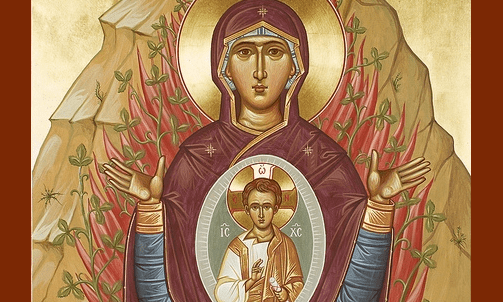By Curtis J. Mitch (writer, editor, and research fellow at the St. Paul Center)

Today the Catholic Church celebrates Mary as “the Mother of God.” Christians have invoked Mary in this way since at least the time of Origen of Alexandria in the early third century.[1] She was officially honored as the Mother of God in 431 at the Council of Ephesus, which ratified the tradition of calling her Theotókos, a Greek term meaning “the God-bearer” or “She who gave birth to God.”[2] This title can sound rather jarring at first, even scandalous, but it need not cause us to fret. Rest assured, the Church has never taught that Mary is greater than God, that Mary is more ancient than God, or that Mary somehow gave birth to God’s divine nature. It simply means that Mary, being the Mother of Jesus, is the Mother of the Son of God.
In fact, the title Theotókos is as much a Christological affirmation as a Mariological one. Its original purpose was to form a wall of protection around Christianity’s cardinal mystery: The Incarnation of Jesus Christ as true God and true man. By insisting on the divine maternity of Mary, the Council of Ephesus was insisting on the full humanity of her Son as well as his full divinity. Both sides of the mystery are expressed here. On the one hand, the motherhood of Mary includes everything that natural motherhood normally includes: she conceived and gave birth to a flesh-and-blood man, Jesus of Nazareth, who lived and died in our human history. On the other hand, Mary’s motherhood, like that of all mothers, entails a relationship to a person and not simply to a nature. It is not enough, then, to claim that Mary is the mother of Jesus’s human nature. The connection between persons, between parent and child, is too essential to be left out of the picture. But here is where things take a turn to the wonderous: Jesus is not a human person but a divine Person! He is God the Son begotten of the Father before all ages. The person-to-person relation between Mary and Jesus is that of a human Mother and a divine Son. This is what the title captures in a nutshell.
The Mariological side of the mystery is scarcely less exquisite. The title Theotókos is surely the highest honor imaginable for any of God’s creatures without crossing over into blasphemy. It is the one truth that explains her whole life and vocation. It is the axis around which every other Marian doctrine revolves and takes its meaning. She is the sole individual chosen by God for the mission of divine motherhood. Every other believer—without exception— is adopted by grace to become a younger brother or sister of Jesus, the “first-born among many brethren” (Romans 8:29). Mary is the one believer whom Jesus can address with the words: “Woman, behold, your son!” (John 19:26). Simply put, the divine motherhood of Mary is the greatest of the “great things” that He who is mighty has done for her (Luke 1:49).
Vastly more can be said about Mary as Theotókos, but not all of it is best expressed in doctrinal formulas or devotional practices. Some of what can be said takes a different form entirely.
One of my favorite attempts to articulate this mystery is based on a passage of the Old Testament. It is the image of Mary as the “burning bush” from Exodus 3:1–6. The story is probably familiar to many of us. Moses is grazing his family flocks near Mount Horeb when he catches sight of a bush that is blazing with fire but is not consumed. As he moves in for a closer look, the Lord calls out with a warning: “Moses, Moses!” he says, “Do not come near; put off your shoes…for the place on which you are standing is holy ground.” Immediately, Moses hides his face out of fear of looking upon the glory of the God of Israel.
The historical meaning of the passage is rather straightforward. This is the moment in Moses’s life when God calls him to be a prophet and the deliverer of his people from bondage in Egypt. The spiritual meaning of the passage, however, is sometimes related to the divine maternity of Mary. Consider the interpretation of Saint Gregory of Nyssa, an extraordinary theologian and bishop of the fourth century. He states:
“What was prefigured at that time in the flame of the bush was openly manifested in the mystery of the Virgin, once an interval of time had passed. Just as on the mountain the bush burned but was not consumed, so also the Virgin gave birth to the light and was not corrupted. Nor should you consider the comparison to the bush to be embarrassing, for it prefigures the God-bearing body of the Virgin.”[3]
Take a moment to let this sink in. Mary, the humble maiden of Nazareth, is the bush set ablaze with divine fire—the same fire that appears throughout salvation history when God manifests his glory to his people.[4] When the Lord took his seat on Mount Sinai, the mountaintop burned and smoked like a kiln (Exodus 19:18). When the Lord came down in a thick cloud upon the Tabernacle in the wilderness, the cloud was aflame with fire (Exodus 40:38). When Elijah staged a demonstration of the Lord’s greatness, God poured down fire from heaven that incinerated both the altar and the sacrifices laid upon it (1 Kings 18:38). And, of course, when the Spirit of God came mightily upon the infant Church, he descended upon the company of believers in the form of fire (Acts 2:3).
The Lord likewise descended upon Mary. Once she gave consent to her vocation, the Spirit of the Most High came upon her, causing her to conceive in her womb a child who is “the Son of God” (Luke 1:35). Now, if Mary’s child is a divine Child, and the divine presence is revealed in fire, then it seems beautifully fitting to see the Burning Bush as a figure of her divine maternity.[5] She bears the fire of God in the heart of her being. And this is no ordinary fire, the kind that consumes and reduces to ash. No, this is the glory of the Lord. When God sets creatures alight with his glory, they are engulfed in his undying life. Men and women are deified rather than diminished in this holy furnace of infinite Being. And the fact that Moses removes his sandals and hides his face before the bush reminds us that even the greatest saints recognize something greater still in Mary—not independently of God, of course, but precisely as the one who bears the living God in her womb.
In view of these wonderous mysteries, let us today join the Church’s chorus in celebrating God’s gifts to Mary, the Mother of God.
Blessed Theotókos, the bush that burns with God, pray for us!
 Curtis Mitch is a writer, editor, and research fellow at the St. Paul Center. He has been a contributor to the popular apologetics series Catholic for a Reason (Emmaus Road Publishing); he has co-authored a commentary on the Gospel of Matthew with Edward Sri in the Catholic Commentary on Sacred Scripture series (Baker Academic); and he is the principal annotator and associate editor of the Ignatius Catholic Study Bible (Ignatius Press). He has also been a guest lecturer in theology at Franciscan University and an online instructor in theology for Catholic Distance University
Curtis Mitch is a writer, editor, and research fellow at the St. Paul Center. He has been a contributor to the popular apologetics series Catholic for a Reason (Emmaus Road Publishing); he has co-authored a commentary on the Gospel of Matthew with Edward Sri in the Catholic Commentary on Sacred Scripture series (Baker Academic); and he is the principal annotator and associate editor of the Ignatius Catholic Study Bible (Ignatius Press). He has also been a guest lecturer in theology at Franciscan University and an online instructor in theology for Catholic Distance University
[1] According to the testimony of Socrates, History of the Church 7.32.
[2] See Denzinger-Hünermann 252.
[3] St. Gregory of Nyssa, On the Birth of Christ, PG 46.1133. English translation adapted from Luigi Gambero, S.M., Mary and the Fathers of the Church: The Blessed Virgin Mary in Patristic Thought, trans. Thomas Buffer (San Francisco: Ignatius Press, 1999), 155.
[4] Over the centuries Christian artists and iconographers have found myriad ways to revel in the connection between Mary and the Burning Bush, especially in Eastern and Russian Orthodox churches.
[5] As well as her uncorrupted virginity, as also stated in St. Gregory’s The Life of Moses 2.21.

